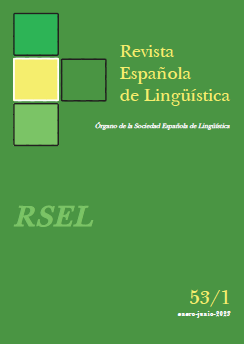La conceptualización de la identidad transgénero en Estados Unidos: un estudio léxico, diacrónico y de corpus
doi: https://doi.org/10.31810/rsel.53.1.10
Palabras clave:
lingüística trans; variación diacrónica; lingüística de corpusResumen
Este estudio examina la conceptualización de la identidad transgénero desde una perspectiva diacrónica. El objetivo principal es analizar el desarrollo de los términos más comunes para referirse al colectivo trans en el contexto estadounidense entre el siglo XX y la actualidad: transvestite («travesti»), transsexual («transexual») y transgender («transgénero»). Para ello, se hace uso de los corpus COHA y COCA y se combinan métodos cuantitativos y cualitativos, se analiza la conceptualización de la identidad trans a través de la frecuencia de uso de las palabras y su prosodia semántica. Los resultados muestran una similitud relativa entre transvestite y transsexual tanto en cuestión de distribución como de uso. Ambos términos surgen en el ámbito médico entre los 70 y 80, y se aprecia un cambio de significado hacia uno más coloquial y negativo en el que, en ocasiones, se conceptualiza a mujeres transgénero en términos despectivos y violentos. Los resultados de transgender son significativamente diferentes en cuanto a que surge hacia 2010 y prevalece en contextos mediáticos, políticos, legales y educativos llevando a una conceptualización plural del colectivo y mostrando connotaciones positivas relacionadas con el movimiento en defensa de los derechos trans.
Descargas
Citas
Baker, P. (2017). American and British English: Divided by a common language?. Cambridge: Cambridge University Press.
Bamman, D., Eisenstein, J., y Schnoebelen, T. (2014). Gender identity and lexical variation in social media. Journal of Sociolinguistics 18(2), 135-160. doi: https://doi.org/10.1111/josl.12080
Barnett, B. S., Nesbit, A. E., y Sorrentino, R. M. (2018). The transgender bathroom debate at the intersection of politics, law, ethics, and science. The Journal of the American Academy of Psychiatry and the Law 46(2), 232-241.
Bauer, L. (2002). Inferring variation and change from public corpora, en J. K. Chambers, N. Schilling-Estes, y P. Trudgill (Eds.), The handbook of language variation and change (pp. 97-114). Oxford: Blackwell Publishing Ltd.
Blank, A. (1999). Why do new meanings occur? A cognitive typology of the motivations for lexical semantic change, en A. Blank y P. Koch, Historical semantics and cognition (pp. 61-90). Berlín: De Gruyter Mouton. doi: https://www.degruyter.com/document/doi/10.1515/9783110804195/html
Calder, J. (2020). Language, gender and sexuality in 2019: Interrogating normativities in the field. Gender and Language 14(4), 429-454. doi: https://doi.org/10.1558/genl.18634
Chambers, J. K. (2013). Patterns of variation including change, en J. K. Chambers y N. Schilling (Eds.) The handbook of language variation and change (pp. 297-323). Oxford: Wiley-Blackwell.
Cooper, H., y Shear, M. D. (2021, enero 25). Biden ends military’s transgender ban, part of broad discrimination fight. The New York Times. doi: https://www.nytimes.com/2021/01/25/us/politics/biden-military-transgender.html
Deo, A. (2015). Diachronic semantics. Annual Review of Linguistics, 1(1), 179-197. doi: https://doi.org/10.1146/annurev-linguist-030514-125100
Geeraerts, D. (1997). Diachronic prototype semantics: A contribution to historical lexicology. Oxford: Oxford University Press.
Goodwin, M., y Chemerinsky, E. (2019). The transgender military ban: Preservation of discriminarion through transformation. Northwestern University Law Review, 114(3), 751-807.
Gries, S., y Hilpert, M. (2008). The identification of stages in diachronic data: Variability-based neighbour clustering. Corpora 3(1), 59-81. doi: https://doi.org/10.3366/E1749503208000075
Hilpert, M. (2011). Diachronic collostructional analysis: How to use it and how to deal with confounding factors, en K. Allan y J. A. Robinson (Eds.), Current methods in historical semantics, (pp. 133-160). Berlín: De Gruyter Mouton. doi: https://doi.org/10.1515/9783110252903.133
Hunston, S. (2007). Semantic prosody revisited. International Journal of Corpus Linguistics, 12(2), 249-268. doi: https://doi.org/10.1075/ijcl.12.2.09hun
Konnelly, L. (2021). Nuance and normativity in trans linguistic research. Journal of Language and Sexuality 10(1), 71-82. doi: https://doi.org/10.1075/jls.00016.kon
Kulick, D. (2000). Gay and lesbian language. Annual Review of Anthropology, 29(1), 243-285. doi: https://doi.org/10.1146/annurev.anthro.29.1.243
Levin, D. (2019, julio 23). North Carolina reaches settlement on ‘Bathroom Bill’. The New York Times. doi: https://www.nytimes.com/2019/07/23/us/north-carolina-transgender-bathrooms.html
Motschenbacher, H. (2018). Corpus linguistics in language and sexuality studies: Taking stock and looking ahead. Journal of Language and Sexuality 7(2), 145-174. doi: https://doi.org/10.1075/jls.17019.mot
Motschenbacher, H., y Stegu, M. (2013). Queer linguistic approaches to discourse. Discourse and Society 24(5), 519-535. doi: https://doi.org/10.1177/0957926513486069
O’Brien, R., y Hartley, R. (1973). Sweet Transvestite [Song].
Robson Day, C., y Nicholls, K. (2021). ‘They don’t think like us’: Exploring attitudes of non-transgender students toward transgender people using discourse analysis. Journal of Homosexuality 68(6), 914-933. doi: https://doi.org/10.1080/00918369.2019.1667161
Schlechtweg, D., Hätty, A., del Tredici, M., Schulte im Walde, S. (2019). A wind of change: Detecting and evaluating lexical semantic change across times and domains. doi: http://arxiv.org/abs/1906.02979
Scorsese, M. (2002). Gangs of New York [Film].
Scott, M. (2015). WordSmith tools manual. Lexical Analysis Software Ltd.
Stewart, D. (2010). Semantic prosody: A critical evaluation. Rutledge.
Stryker, S. (2008). Transgender history, homonormativity, and disciplinarity. Radical History Review 2008(100), 145-157. doi: https://doi.org/10.1215/01636545-2007-026
Törmä, K. (2018). Collocates of trans, transgender(s) and transexual(s) in British newspapers: A corpus-assisted critical discourse analysis. doi: http://urn.kb.se/resolve?urn=urn:nbn:se:miun:diva-34339
Zhang, Q. F. (2014). Transgender representation by the people’s daily since 1949. Sexuality and Culture 18(1), 180-195. doi: https://doi.org/10.1007/s12119-013-9184-3
Zimman, L. (2020). Transgender language, transgender moment: Toward a trans linguistics, en K. Hall y R. Barrett (Eds.), The Oxford handbook of language and sexuality. Oxford: Oxford University Press. doi: https://doi.org/10.1093/oxfordhb/9780190212926.013.45
Zimman, L., y Hayworth, W. (2020). How we got here: Short-scale change in identity labels for trans, cis, and non-binary people in the 2000s. Proceedings of the Linguistic Society of America 5(1), 499. doi: https://doi.org/10.3765/plsa.v5i1.4728
Zottola, A. (2018). Transgender identity labels in the British press: A corpus-based discourse analysis. Journal of Language and Sexuality 7(2), 237-262. doi: https://doi.org/10.1075/jls.17017.zot
Publicado
Cómo citar
Número
Sección
Derechos de autor 2023 Revista Española de Lingüística

Esta obra está bajo una licencia internacional Creative Commons Atribución-NoComercial-SinDerivadas 4.0.











